Witches
Feared for their arcane and sorcerous powers, the witches maintain their own underground community
As seen in
The body was swinging from its neck and its head lolled at a grotesque angle. Its face was a mummified horror, frozen in deadly rictus. Its eyes were gone. The fluttering cloth was what remained of wind-tattered robes. The crossbar that had formed the ominous shape was a board upon which someone had scrawled the word NEKROMANSER with red barn paint. It hung from the lynched man’s neck, dangling across his chest. His hands had been nailed to it and the board was stained black with blood.While divine powers are respected in the Wyrd West, the powers of sorcery and arcane magic are feared. But there are those who are born with sorcerous powers, and there are those who study the Art Magical. And then there are some for whom magic and faith are one. Witches are those who choose to practice their Talents and their Arts in a way that doesn't differentiate between them. Some are Pagans who practice ancient religions; others are cunning folk and natural healers; still others are servants of dark powers. Whatever the case, witches delve into "all of the above" areas of magic.
A Note About Gender
While some people associate the term "witch" strictly with women, the term is not a gendered one among witches themselves.“I need something a bit more advanced on blood magic.” Now he raised the other eyebrow. “Surely you must have something of that nature in your collection already! You have a number of books on ritual magick, witchcraft, Haitian Voudou . . .” “Surprisingly, they don’t have much to say on the subject,” Janice said with a sigh. “I have the Haitian zombie formula, but it has nothing to do with blood. Crowley, the OTO and related have all kinds of information about the use of sexual fluids, but about blood, nothing. And there’s so many different forms of witchcraft. The closest I could come there was a women’s menstrual ceremony that involves painting oneself with one’s own blood. It’s supposed to be a way to embrace the sacred feminine, or something.” She shuddered. “Why anyone should want to do that, I cannot possibly imagine. Do you think that the Book of Abramelin might have such a thing?”
Naming Traditions
Feminine names
In some traditions, Craft names among female witches tend to draw from the mythologies and lore of witches past. They usually suggest mystery, power, and a special harmonic relationship with nature. Some are evocative of seduction; others of raw Amazonian strength. Many are inspired by symbols associated with Goddesses, especially Goddesses of magic and witchcraft.
Examples: Lady Ravenwood, Moondancer, Wolf-Woman, Lilith Nightshade, Diana-of-the-Moor, Dreamweaver, Bruna Freyadotter, Valentina Aradia, Brighid Morrighan, Shadowcat, Dana Frostfire.
Masculine names
In traditions with Craft names, masculine Craft names are also inspired by the mythology and lore of witches past, but their names tend to evoke strength, wisdom and harmony with nature. They are often inspired by symbols associated with Pagan gods. It is sometimes easier to spot the servants of sinister Powers by masculine Craft names.
Examples: Lord Winter, Eagle Eyes, Amergin, Peregrine, Rainwalker, Cat, Wolfshadow, Cernunnos Rei, Midnight, Morningstar Rising.
Unisex names
Witches can come from any culture of origin that is present in the Wyrd West, and therefore, have a variety of proper names.
Family names
Sorcerous powers tend to run in families, and often, so do folk witchcraft traditions. Some families from the Appalachian Mountains, hexen families, Slavic witches, and cunning-folk families have maintained these traditions for hundreds of years. There is also a large group of hereditary Wiccans in the Okanagan Lake region. Appalachian names tend to be Irish and Dutch in origin; hexen names are Germanic; cunning-folk are found in most Old World cultures; and Wiccan families come in literally every ethnic variety under the sun.
Other names
True Names
Some traditions believe that every being with a soul has a True Name; that is, a magical invocation that is specifically geared to them. Some say it is given to them by their gods; others that it represents their essential "vibration" (the tone or sound that created them). If a witch knows their True Name, they guard the knowledge jealously. Knowing a witch's True Name may give you considerable power over them -- if you know what to do with it.Craft Names
Witches also tend to take names to represent themselves as witches and what it is they stand for. This serves the dual purpose of protecting their true identities. If their fellow and sister witches don't know their given names, they can't tell anyone else who might come asking. Titles vary between faiths. Wiccans and Luciferans might use "Lord" or "Lady" to denote a High Priest or Priestess, for example, but that doesn't mean that every witch uses those titles. For Wiccans, it symbolizes their link with The Lord and the Lady.Examples:
- Lady Nightsong (a Wiccan High Priestess who loves listening to the twilight chorus of bugs and birds, and who thinks of herself as moving in that liminal space)
- Papa Moore (a Voudun)
- Astrid Heladotter (a Norse volva who serves the goddess Hel)
- Baba Katerina (a Russian cunning-woman)
- Lucretia Lacuna (a Satanic witch and priestess)
He’d never seen a ritual room before, but that was what this had to be. Supplies such as candles and oils were stored on a shelf, and there was a plain white circle painted on to the hardwood floor. His first instinct was to torch the place, but he reconsidered. He knew his magic wasn’t born of either a nefarious source or a nefarious purpose, and neither was Laughing Bear’s, so why assume that studied magic was all dark? Perhaps benevolent people also practiced the so-called “Dark Arts.”
Culture
Major language groups and dialects
It is not uncommon for witches to speak, and especially read, a variety of dead and ancient languages, since they spend a great deal of time poking around in ancient tomes. But because they hail from a variety of linguistic, cultural and religious traditions, there is no common language. However, there are several magical languages used for spellwork or as cyphers among themselves. Common examples include Runic, Ogham, Enochian, and Theban, the "Witches' Runes."
Shared customary codes and values
Witches have little patience with the culture of the Wyrd West and its "superstitious fear" of arcane and sorcerous powers. They resent having to keep their abilities hidden, and yet, they are not stupid enough (usually) to flaunt such powers in public. It's considered perfectly legitimate, apparently by ancient tradition, to keep the accouterments of one's Craft hidden, and even to publicly denounce one's deities if necessary.
By no means can it be said that witches universally get along -- rivalries, and even significant ethical and moral disagreements, are quite common. Sometimes known as "Witch Wars," these conflicts can get deep, dirty, and full of resentments. While they rarely result in magical duels in the middle of the street, they may involve endless curses and counter-curses, and constant petty harassment of the witch and their immediate friends and family. However, a witch will never willingly "out" another witch, no matter how much they might disagree, or how much they might even hate one another.
It's also important to note that intent has a significant place in the practice of witchcraft. Just because a witch chooses to practice a "Dark Art," does not make them "evil." Necromancers might, for example, use their powers to call back the spirits of loved ones so that their living relatives can make peace over an unresolved issue. Demonologists might use their powers of binding to capture and imprison demons infesting a haunted house. For benevolent witches, it's not about the nature of the powers you use, but what you do with them.
Common Etiquette rules
Witches with a shared tradition, or shared values, often get together to celebrate holidays or practice magic. However, if two witches cannot set aside their differences in the ritual space, then one or the other is expected to sit out and not take part.
Common Dress code
Witches value self-expression, whatever forms that takes. Those in the know may sometimes be able to spot them by seeking out groups with unusual clothing (especially long, flowing dresses, skirts, or cloaks), flashy jewelry of magical metals with precious stones and crystals, or a variety of tattoos, brands, and piercings. However, some witches are much more careful about not drawing suspicion, so none of that is a given.
It's not uncommon for those who follow darker powers to prefer dark colours in their fashion. However, "dark" does not necessarily mean "evil." Witches may follow a variety of dark and mysterious deities associated with death or wisdom that are neutral, or even positive, Powers.
Most of the Afro-Caribbean traditions can be recognized by their "whites," which are kept specifically for ritual.
Many Wiccans practice their rites "skyclad" - that is, in the nude. Satanists and Goddess-worshipers sometimes do this as well.
Art & Architecture
The ritual room was in the fully-finished basement. It was kept as bare and as spartan as possible so that a variety of magical practices, whether for benevolent or nefarious purposes, could be practiced in the space. There was a seemingly unlimited supply of candles in all colours. There were mats to accommodate summoning circles, pentacles, solar crosses, or medicine wheels. Wall hangings were sometimes used when symbols of the four elemental quarters, the Kaballistic Tree of Life, runes or sigils were required.Art and crafts are highly valued. Witches incorporate occult symbolism into their artwork, and indeed, they may use their artwork as a spell. Examples include spinning, wraving, tattooing, painting and musical composition and performance. Veves, which are symbols that represent The Loa, are a form of art intended to be temporary. The rituals of witchcraft can be considered a form of performance art in and of themselves. And the variety of music in witchcraft, from singing, chanting, and story-songs, to freeform drum circles and spontaneous compositions, is mindblowing.
Common Customs, traditions and rituals
Witches encourage a "live and let live" attitude. They are slow to judge the behaviour and beliefs of others. While this can be an asset in many ways, as a lot of "outsiders" find a home among them, it also leaves openings for disingenuous and manipulative people to take advantage of others.
Many witches come from traditions that celebrate the Solstices, the Equinoxes, and the other cross-quarters that would be recognized in the Gunslinger Order. So there are usually Sabbats to be celebrated somewhere on each one of these holidays. Other important dates include full moons, new moons, and eclipses, depending, again, on tradition.
Birth & Baptismal Rites
Most witches are born with either sorcerous or psychic powers, and it is that innate sense of being different from others around them that drives them to seek out things occult. This isn't a universal trait, however -- some people are simply driven to seek out forbidden knowledge.
Many are born with cauls, or with "witch marks" -- that is to say, birthmarks or moles that are near to intimate areas of the body. Some are born with a "witch's nipple" -- which is usually just a mole that is roughly where a third nipple might be, but sometimes is an actual nipple. All of these are considered signs of potential sorcery, and highly valued among witches.
Common Taboos
Under no circumstances will a witch ever betray the identity of another witch, no matter how ethically or morally opposed they might be to one another. The secret society of witches only operates successfully because of this rigid taboo. Without it, witches could find no place of safety and no way to share knowledge and information.
Historical figures
Ideals
Gender Ideals
Witches of folk traditions sometimes have rigorously-defined gender roles. Others, especially of the Pagan traditions, resent the idea of gender roles being imposed upon them. Trans, queer, and non-binary folks are over-represented among Wiccans and other Pagan witches.
Relationship Ideals
Witches are notoriously willing to flaunt the social norms when it comes to relationships. They tend to live and love freely. While monogamous heterosexual couples can and do exist among witches, no one thinks anything of unusual or unorthodox relationships. Witches have much better things to do than police whom people are or are not sleeping with.
Remember that you can click on the glowing gear icon on the left of the screen to access the menu at any time!
Published Books
Serial:
#1 Showdown
#3
The Vigil
#5
The Reaping
Novel:
Once Upon a Time in the Wyrd West (Wyrd West Chronicles #1-6)
Anthology:
Gunsmoke & Dragonfire (featuring The Teeth of Winter (Wyrd West Chronicles #7)
Subcultures Within a Counterculture
There are many different approaches to witchcraft, and many different people identify as witches. Here a few examples of significant "traditions" (as they call them) within the culture:- Wiccans and Neo-Pagan witches
- Cunning-folk and kitchen witches
- Folk witches such as the Strega and the Volva (Norse folk witches)
- Practitioners of Afro-Caribbean or Afro-Diasporic faiths, such as Voodoo or Santeria
- Necromancers
- Luciferians and other worshipers of dark powers
First, a self-invented charm. Out of a small bleached leather bag, with a drawstring fixed with raven feathers, she fished out a few tiny objects; finger-bones taken from the corpses of children. Oh, not ones she’d killed directly, as a rule. More often than not, she’d dug them up. That one house for poor mothers in Cowtown had been a particularly lucrative find, and there were always a few here and there in graveyards, because bones lasted a lot longer than flesh or the connective tissue that joined them. They were particularly useful as temporary spirit vessels. Donning her rubber gloves, and fixing a scarf over her face to avoid breathing the dust, she took a small hand drill and carefully made holes in each of them. It seemed to take a long time, but she was patient. Once the holes were big enough, she poured out the tiny bag of lodestones she kept. Most witches insisted on natural lodestones, but Janice had discovered how to magnetize them with an electromagnet through a gnomish ex-lover, and they worked just as well. Into each hole she fixed a lodestone, and sealed it with epoxy. That accomplished, she painted a name on each in lampblack ink, using the Theban script, which was the ancient magical alphabet of the witches. Then she whispered those names and blew on them to give the talismans a semblance of “life.”
Jar Filled with Dried Herbs by Kathy Zinn

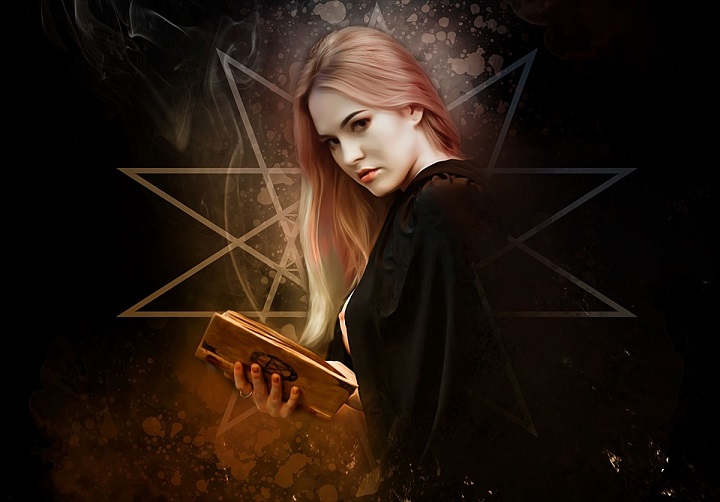
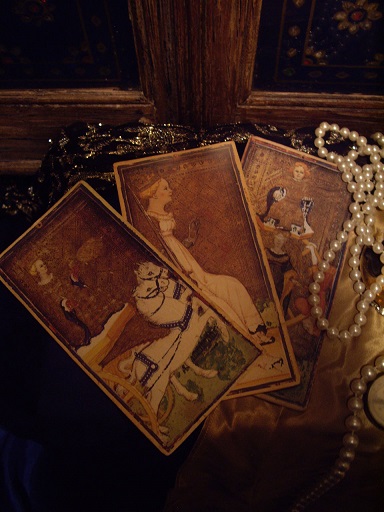
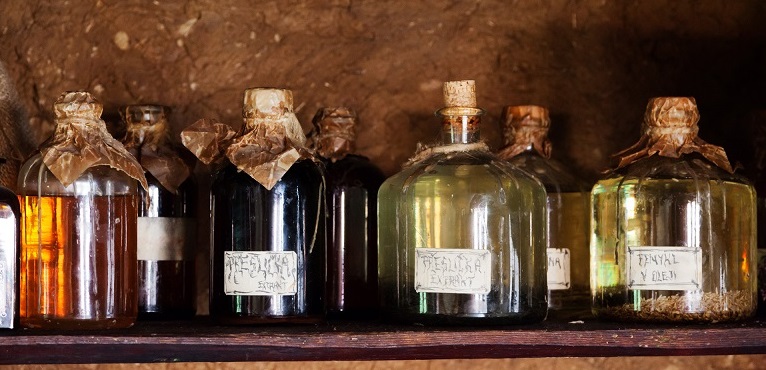
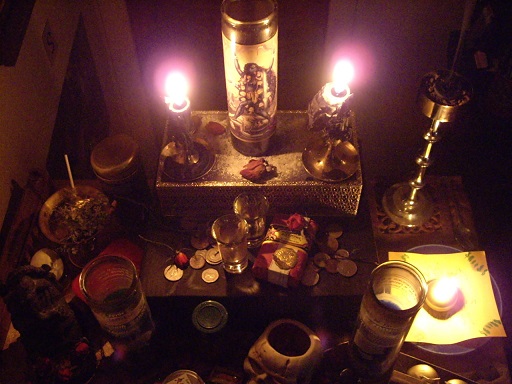
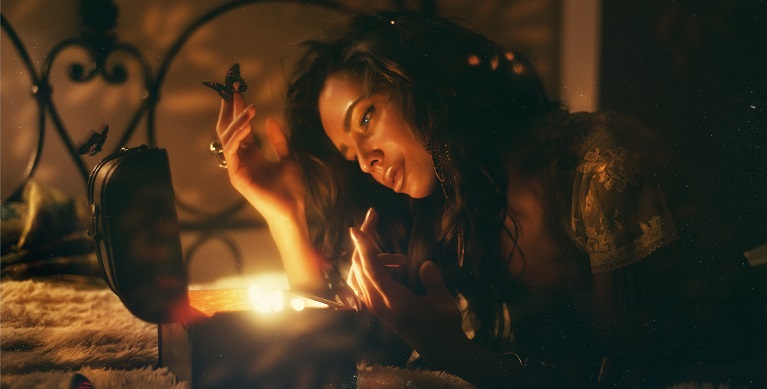


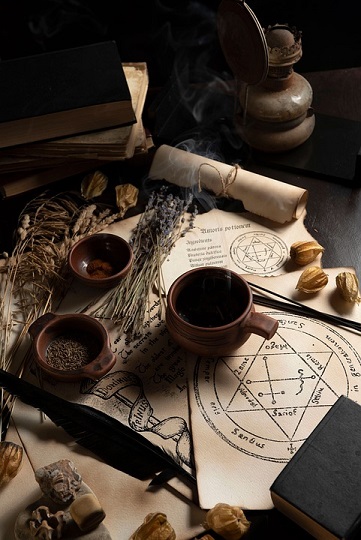
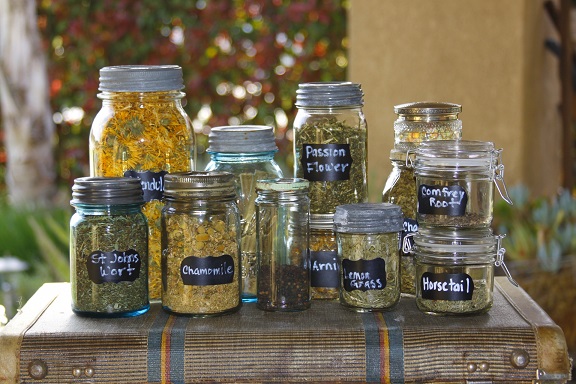



I absolutely love this article, both as a writer and a fellow witch as well. I personally find it hard to explain the difference between my fantasy world's magic and what I actually do, especially when I draw heavily from actual practices, but it seems that you managed to do it quite well. This article is incredibly well written and a joy to read.
Thank you so much! And merry met!